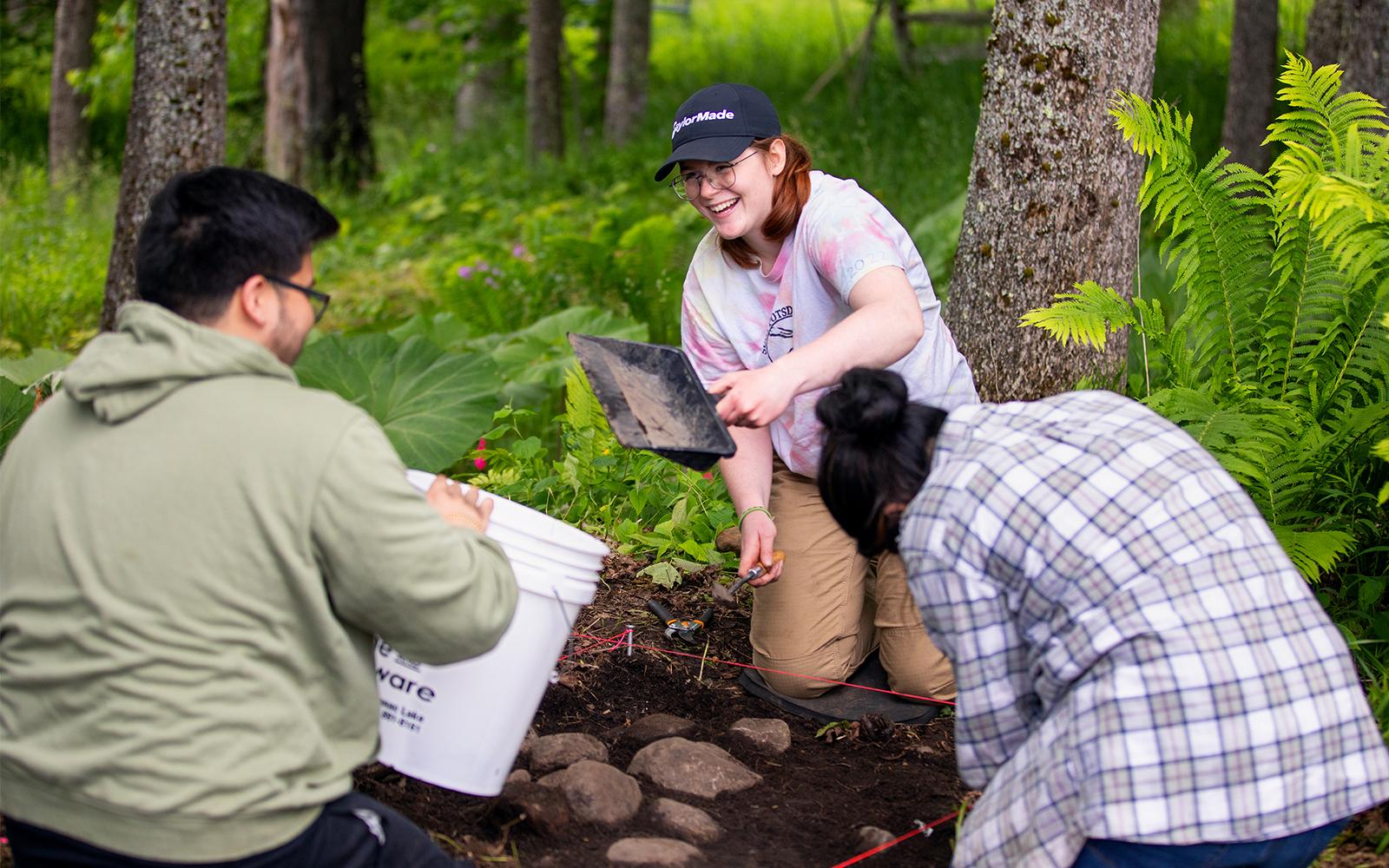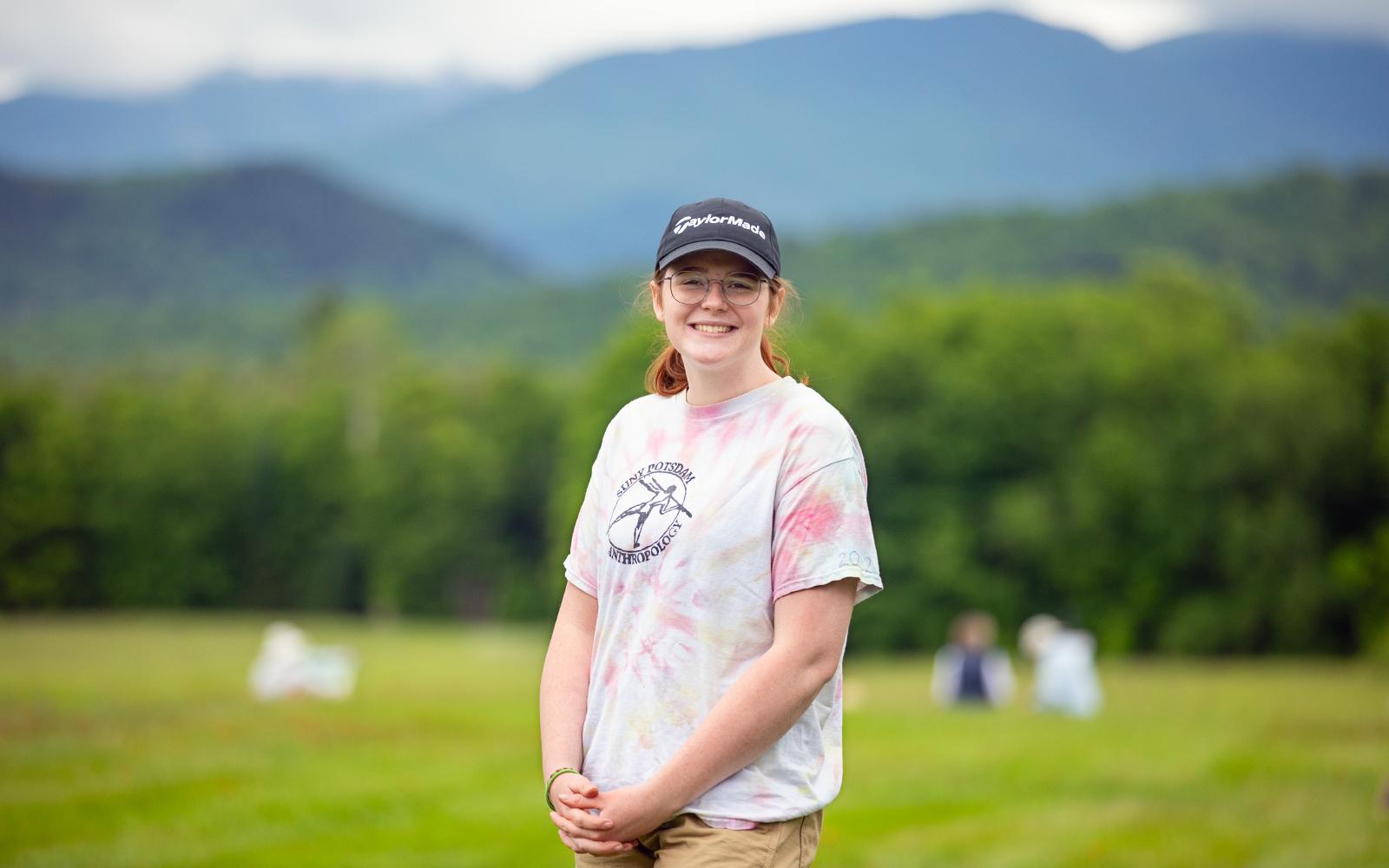Just three days after walking across the Commencement stage, Sydney O'Melia ’24 was already working in the real world, applying skills from her undergraduate degree in archaeological studies.
Hired to work within Fort Drum’s Cultural Resources Program, under the umbrella of the U.S. Army’s Environmental Division, O'Melia has been conducting archaeological research on the military base’s expansive 107,265-acre property. As a field technician, she has been helping to identify and protect Native American artifacts found at Fort Drum, and as needed, safeguard parcels of land from future development.
“We have been digging a lot of shovel test pits, and surveying areas for projectile points, flakes, and anything that reveals evidence of Native American material culture,” O'Melia said. “The main goal of our research is to make sure there aren’t any Native American artifacts or cultural remains because these sites are either going to be used for harvesting, land development, or training areas, and they don’t want to disrupt the land if artifacts are present. We have to approve whatever the government wants to do with that land.”
After two weeks in the field, O'Melia took a brief hiatus to complete a final capstone experience for her archaeological studies degree at SUNY Potsdam, a month-long archaeological field school with Dr. Hadley Kruczek-Aaron. Alongside her classmates, she traveled to Lake Placid, N.Y., to unearth layer after layer of soil in search of 19th-century artifacts on the historic Heaven Hill Farm.
“We learned about Anna Newman and all the people who worked there. We found some awesome things as we were excavating our units, did some compass work and grid mapping, and used a total station. It was really nice getting to learn more about the techniques," she said.
Unlike other students in the field school, many of whom are still entering their junior or senior years, O'Melia had already taken Kruczek-Aaron’s Archaeological Techniques class—a course focused on cleaning, cataloging, and conducting vessel reconstruction of artifacts after a dig. In reverse order of her classmates, O’Melia knew exactly how the artifacts would be processed once back in the lab at SUNY Potsdam.
“I was able to help people with identification because I’ve had that experience. It was a really fun class. You get to puzzle piece some of the ceramics together and try to recreate the vessels. You cataloged everything, they go into a big database, and we make charts and graphs to contextualize all the artifacts we found,” she said.

A first-generation college student who was named to the President’s List five times during her undergraduate years at SUNY Potsdam, O’Melia embraced the applied learning experiences that come standard in the archaeological studies program. She took Kruczek-Aaron’s Archaeology of Black Lives class and Experimental Archaeology with Dr. Tim Messner while working in the new HEARTH (Hand-crafted, Experiential, Archaeological Research and Teaching Hub). “All the professors in the Department of Anthropology are great here. The students and professors are so engaged. It’s a little community. I felt like the professors cared about me, my work, and my interests,” she said.
A transfer student from Paul Smith’s College, O’Melia chose Potsdam for the depth of academic offerings, the College’s proximity to home, and the reasonable cost of education.
“When I was looking for schools, SUNY Potsdam had archaeology, anthropology, and geology. I was like, ‘This is cool, they have everything.’ I also live near Watertown, so it’s not too far from home, and It’s a SUNY school so it’s a lot cheaper than some of the private institutions. With all those factors I came to Potsdam."

During her senior year, O’Melia lined up an internship at the Potsdam Public Museum after artifacts were found in a historic sandstone house in downtown Potsdam from the 1830s. Working alongside the museum staff, she helped to sort through the artifacts, implement skills from her Archaeological Techniques class, and effectively archive the historic items.
“The artifacts were scattered throughout the house. Some were in the walls, some were in the floorboards, and some were found in the front and back yards. It was a great experience. I got to learn more about the museum cataloging system and accessioning, which will help me in the future if I choose to go into museum work," she said.
Now, with her field school complete and her degree in hand, she’s back at Fort Drum searching for signs of Native American artifacts. As she works in the field, she draws connections between her archaeological research and information she learned from her Experimental Archaeology course with Messner. “In that class, we learned how Native Americans might have used quartz-like material or obsidian to make projectile points. It relates to my Fort Drum job now. If I see flakes, that could be indicative of flint knapping in the field,” she said.
As she looks ahead, O’Melia is excited about the broad range of options within her field of study. From pre-historic or historical anthropology to forensic or biological anthropology, she has many paths to choose from, including a career in museum studies. “There are just so many avenues and I think that SUNY Potsdam does such a great job of encompassing all of them. You really get to touch on all of the different parts of anthropology, and it gives you an appreciation for everything,” she said. “I want to get my master’s degree at some point, and possibly my Ph.D. to become a professor, but right now, I’m in my exploration phase. I want to learn more about different cultures, maybe do some museum work, and get some experience to guide my path.”
Article and photos by Jason Hunter
